Em-Trak’s premium Nexus VHF AIS MOB system will compete with improved Garmin Cortex & Icom M510 EVO
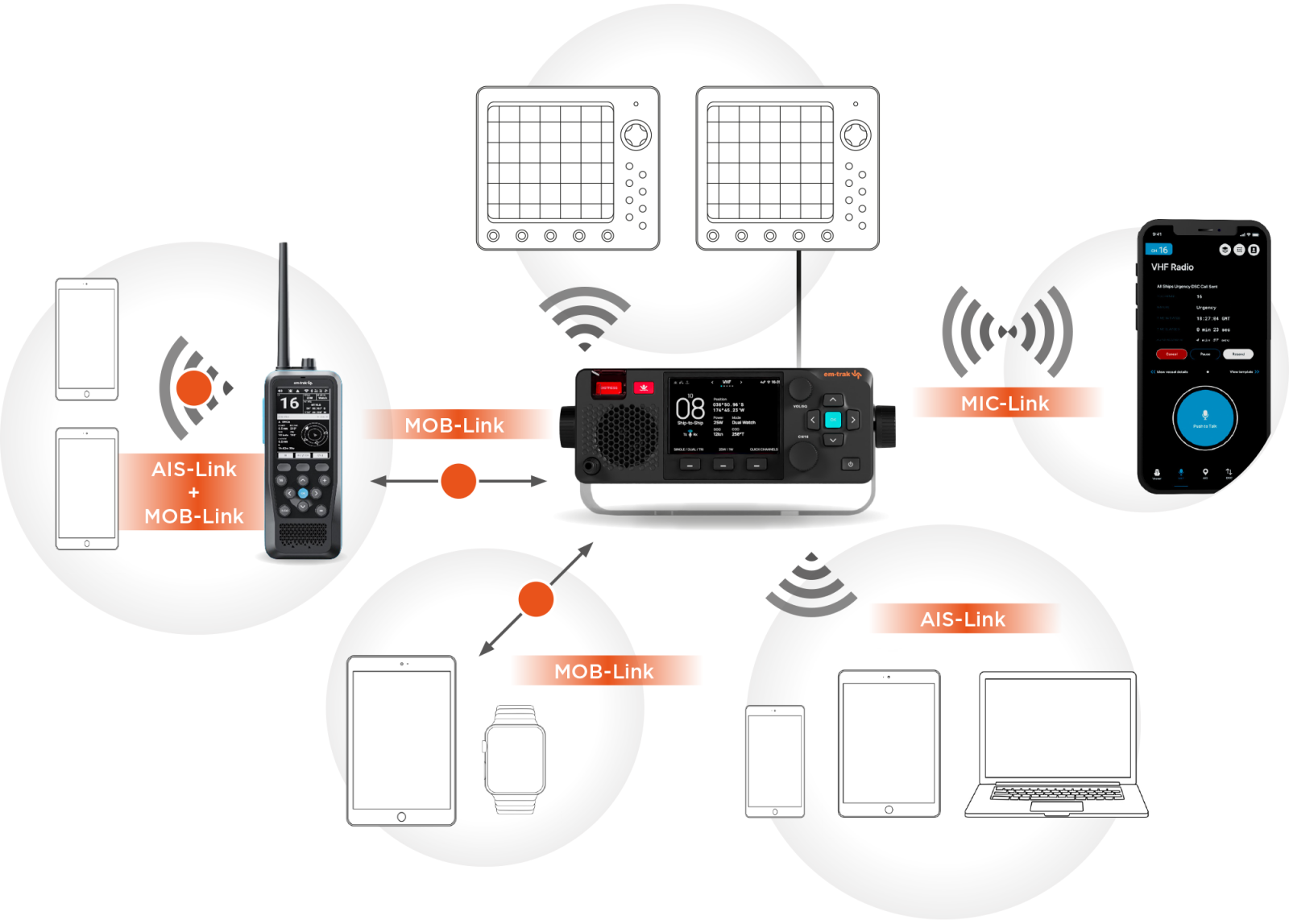
This entry is mainly about the new Em-Trak Nexus VHF/AIS/MOB system intriguingly diagramed above. Nexus was previewed at METS and will hopefully come to market later this year, but I’d like to preface the system’s details with some thoughts on the bigger picture, which Em-Trak headlines as “Redefining Maritime Communications”.
There’s no doubt in my mind that essential marine comms — VHF and its relatively young digital siblings, DSC and AIS — can be significantly improved with modern technologies. A good example is how the Icom M510 suddenly made it possible to use smartphones as extra VHF command mics, and even as a Wifi intercom with the base station. And when you combine modernized VHF with an AIS transceiver, the possibilities seem endless, as already illustrated by the wildly ambitious Vesper Cortex.
But both those systems came to market with significant flaws, at least for some loudly frustrated users, and at this point potential buyers are often scared away by the resulting online negativity. Conclusion? “Redefining Maritime Communications” — a slogan Icom also favors, while Cortex went with “VHF Reimagined” — is darn hard to do!
However, both the IcomM510 and the Cortex (now a Garmin product) were significantly improved in the last year, and may now be of interest to boaters put off by the birthing pains. Plus, discussing these products as they’ve now evolved is useful to understanding what the Em-Trak Nexus is designed to accomplish.
Icom M510 EVO
When I wrote up the new Icom M510 in 2021, I didn’t know that a command mic smartphone app was even possible, given the thicket of strict regulations around marine VHF radios. And the fact that no other manufacturer has yet improved on, or even duplicated, the feature speaks to my contention that innovation in this area is challenging.
To me, the smartphone integration looked like a great idea at first sight, and I’m told that it has become quite popular. But my write-up also questioned Icom’s unusual decision to make the NMEA 2000 and hailer ports only available via a separately installed and costly WiFi interface, although these ports are nearly standard on the backs of other premium VHF radios, including Icom’s own. I guess the CTM500 design could also be termed innovative, but to what end?
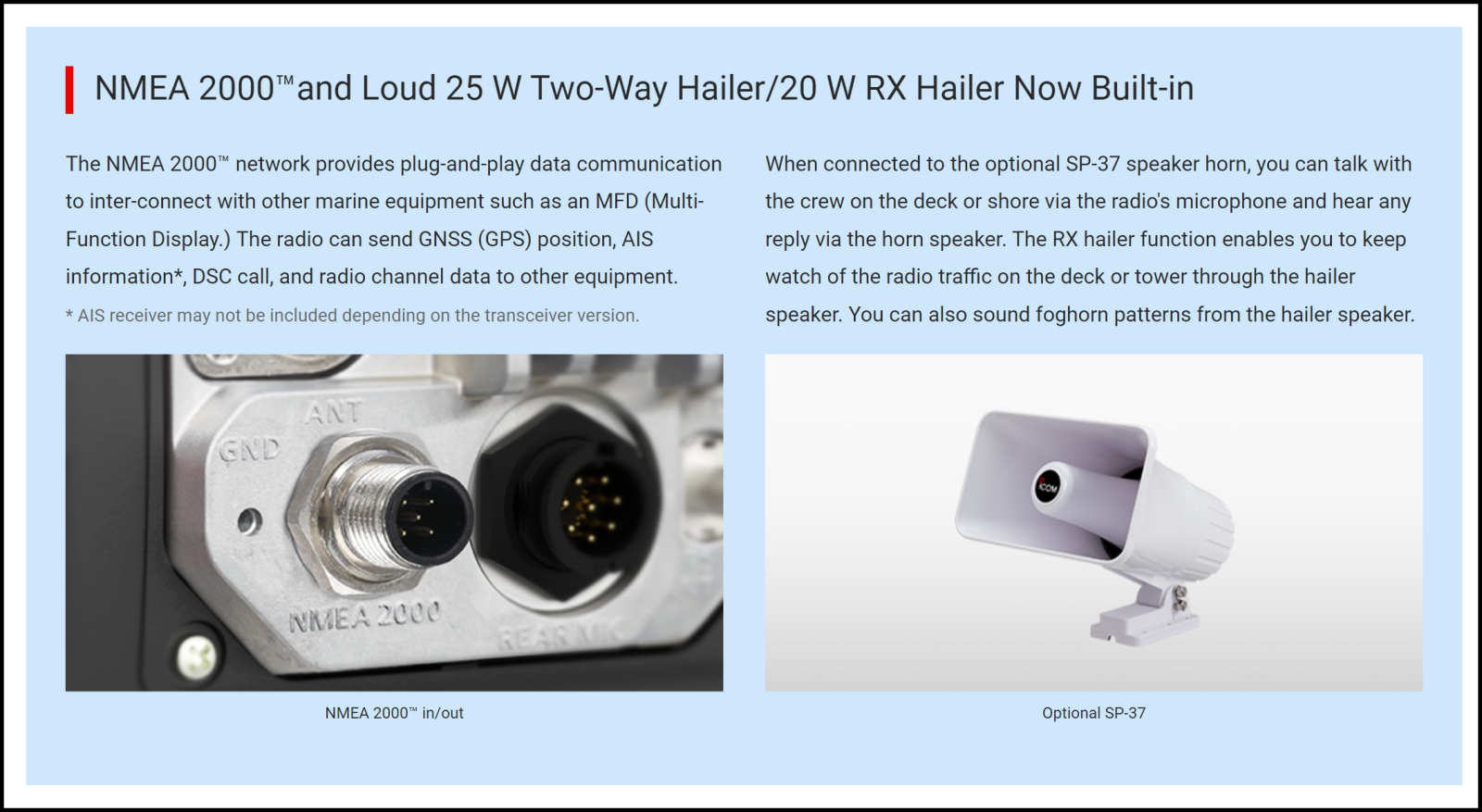
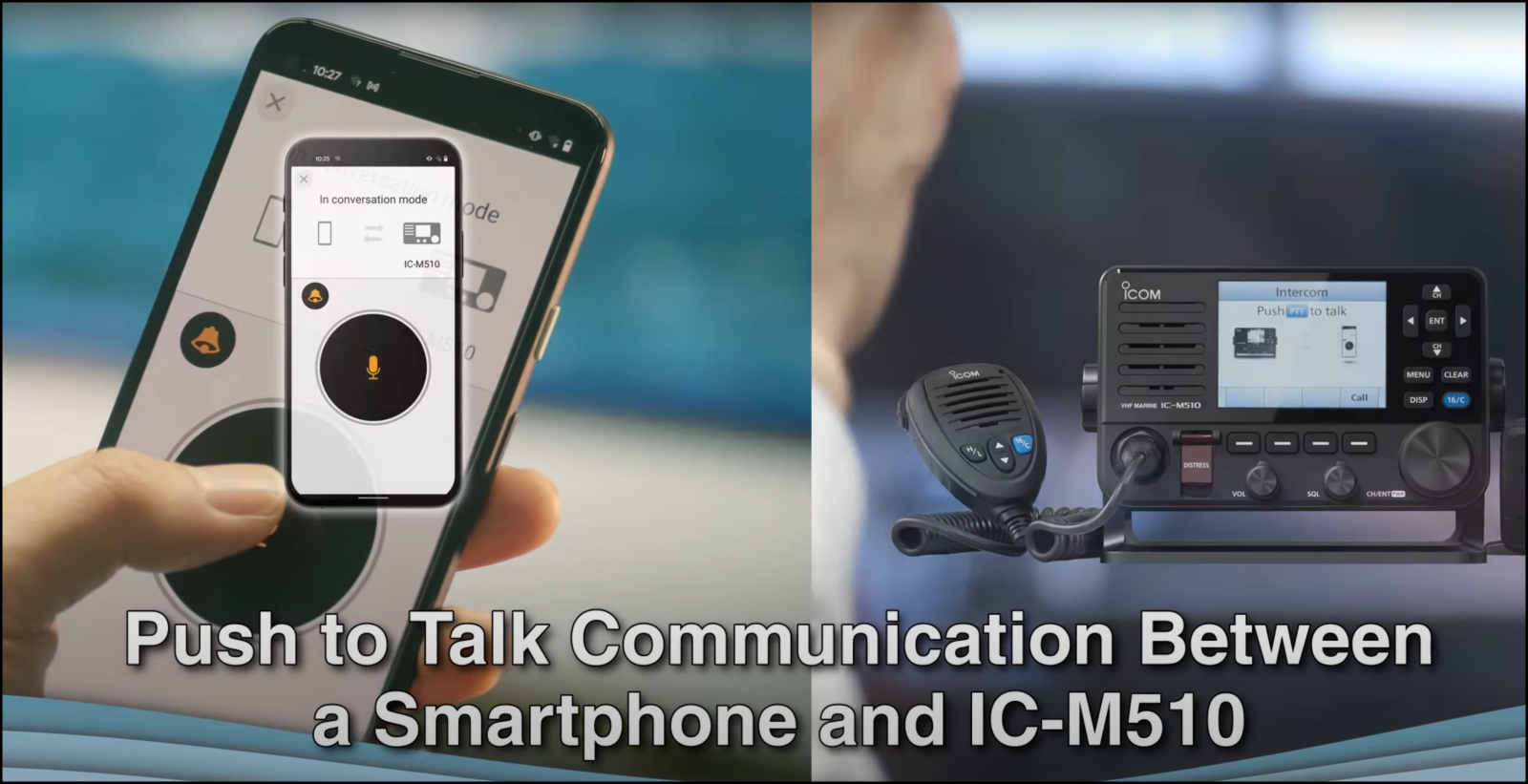
Well, as of recently, Icom’s decision-making has evolved. As best I can tell, the only differences between the original M510 and the new Icom M510 EVO are standard N2K and hailer ports right on the radio. So a full-featured EVO install is going to be easier and more reliable, and at a street price around $800 — or $950 for the model with an AIS receiver built in, sometimes called the “EVO Plus” — it is arguably a less expensive install than the original two-part M510.
While I have not personally tested any M510 model, Icom dealers tell me that customers are pleased with app, especially its intercom function, and it’s easy to understand why. Picture a skipper or crew using the Icom RS-500 app for VHF on their familiar phone anywhere on the boat covered by the M510’s WiFi signal (or the boat’s own WiFi router, as the M510 supports client mode). And then the same gear setup lets them talk app-to-base-station during docking and similar maneuvers. Moreover, that’s nearly hands-free intercom for anyone with a Bluetooth headset — ‘nearly’ because the feature is still half duplex, push-to-talk — and especially attractive to geezers like me almost always wearing hearing aids paired with our phones.
The M510 EVO also has a bright color display similar to the big Icom IC-M605 I did test for two seasons on Gizmo, and thus I can attest that crisp color does make VHF screen information and menus easier to understand at a glance. But while the EVO with more sensible N2K and hailer connections may be of immediate interest, read on to see how the Em-Trak Nexus-Base — also sporting a 3.5-inch color display — will vastly expand on the smartphone as command mic concept.
Garmin Cortex v2
Ben Stein and I weren’t the only excited boat guys when Vesper announced Cortex in late 2019. After initial testing, the rich capabilities of just the M1 hub impressed me big time, and they’ve only gotten better since. However, I left the VHF side of Cortex out of that late 2020 review largely because some major improvements were said to be right around the corner.
Well, that corner got turned very slowly! And while the spectacular promised VHF features failed to materialize, a Panbo entry about early Cortex bugs generated hundreds of comments, some expressing significant owner frustrations… frustrations not just with the conventional v1 VHF audio performance, but also handset failures, hub-to-handset WiFi unreliability, forced reboots, etc. And there was more of the same when Garmin acquired Vesper in 2022 and then dropped venerable pre-Cortex Vesper models in 2023.
Yike! This was all rather depressing, even for those of us who did not experience any of those issues and got to enjoy the slow advent of system features missing in the initial Cortex, like outstanding hailer control. However, Cortex development radically accelerated last Spring when Garmin finally introduced v2 software that unleashed the powerful software-defined radio (SDR) technology that’s always been inside the M1 hub, and then went on to rapidly improve its performance during the Summer and Fall…
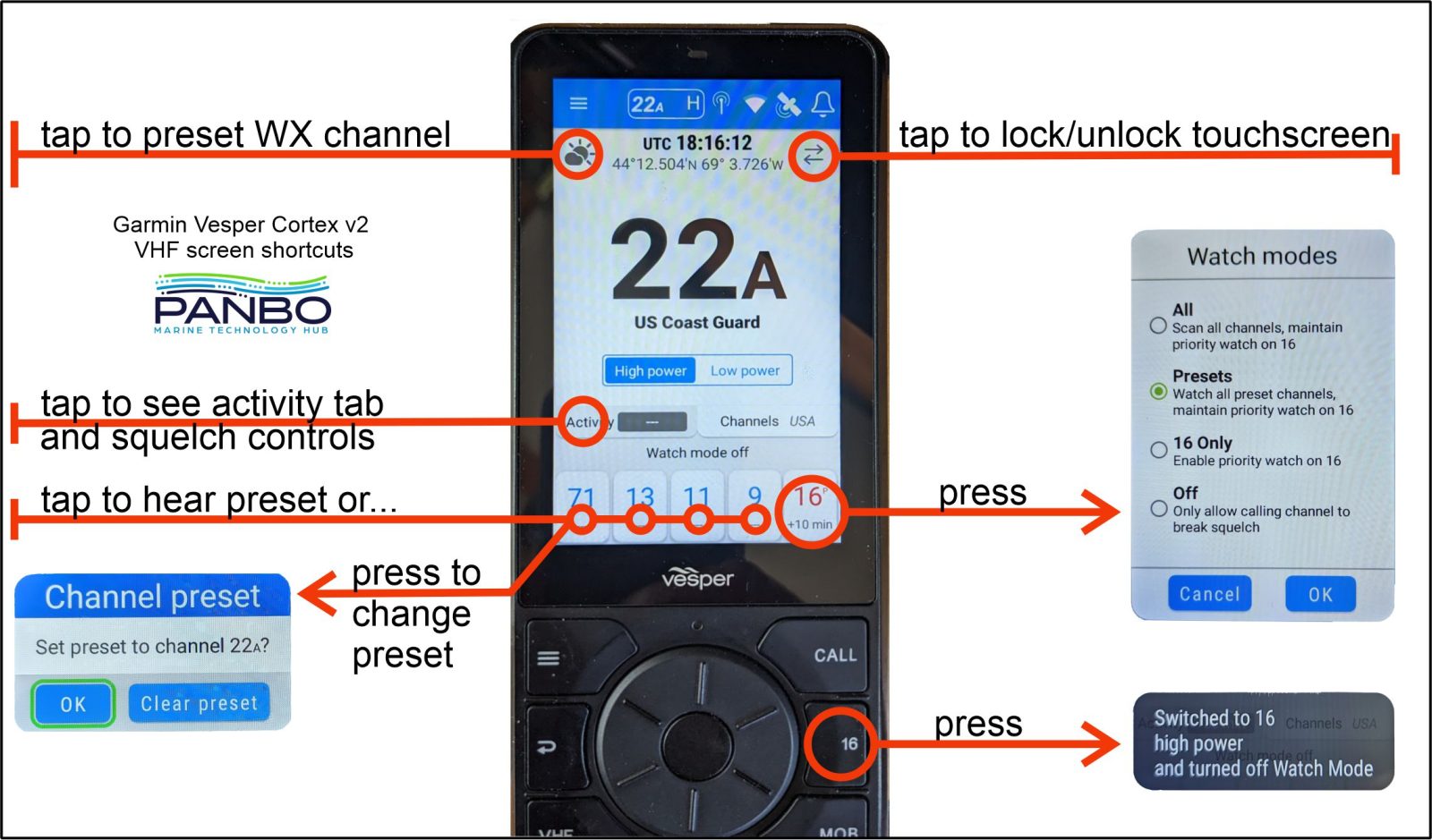
Indeed, after a great many hours of testing Cortex v2 on board Gizmo last season, I think that it now offers the most sophisticated marine VHF ever seen and heard, and by a wide margin! I also took a lot videos for a comprehensive review, and even created the v2 VHF interface guide above (since the Cortex manuals have not been updated since 2022). Apologies for failing to edit those videos yet — and thanks to Garmin for being even slower — but in the meantime please accept this summary of Cortex v2’s remarkable VHF performance:
First, it helps to understand that under v2 my almost always powered-up Cortex M1 hub constantly scans the entire marine VHF spectrum looking for transmit activity and then demodulates and records at least four channels simultaneously and prioritized on good sense and my preset favorites. So much of the magic is already done when I step aboard and fire up the H1 handset mounted at Gizmo’s lower helm.
For instance, I can immediately see if there’s been recent traffic on 16 or any of my harbor’s four main working channels, which are my normal Presets, though easily changed. If that traffic has been in the last three minutes, I can touch flip to that channel’s Activity tab and see the transmissions neatly graphed, play them back, and even save the recordings to a folder in the Hub that can later be copied to my Android phone or iPad.
Then I decide on an appropriate v2 Watch mode. If I want to focus, or listen to something else, the Off or 16 Only modes still allow me visual monitoring of the four Presets, 16 and whatever other channel I’ve last selected. But if I want to hear what’s going on as it happens, Preset mode will flip around as any of the five or six channels seen on the Cortex VHF screen break squelch, or I can even scan the entire marine band.
In fact, Cortex v2 is the only VHF I’ve ever tried that can Watch All channels for long periods with little or no squelch control intervention. That’s because the developers have so perfected auto squelch control, at least by last October’s v2.1.25 firmware release, and also because Cortex can remember custom squelch settings for the few individual channels (in my area) that sometimes defy automation.
Incidentally, for more detail on v2 see Garmin’s Cortex Release History page and especially the illustrated v2.0 Release Notes, the related v2.0 F.A.Q, and the later v2.1 Notes (all of which could helpfully update those old manuals). Then again, some Cortex v2 nuance isn’t explained anywhere I’m aware of, like how the saved recording folder includes multiple channels captured over the preceding three minutes plus a text file of relevant NMEA 0183 data, all of which could be invaluable for documenting incidents involving VHF. (And I already have some doozies, though thankfully they don’t involve me.)
In conclusion, Garmin Cortex v2 has vastly improved my access to the local marine radio world, and I don’t know of any other VHF transceiver using SDR technology to enable such advanced features, including the Em-Trak Nexus we are about to discuss. But even as I was enjoying v2 last season, other Cortex owners were reporting ongoing issues, and a couple of long-promised features like handset-to-handset intercom and Cortex-to-Cortex voice scrambling still haven’t materialized.
On the other hand, Cortex’s built-in low-loss antenna splitter nicely supports a second VHF set for redundancy and missing functionality, while its easy Cortex Onboard firmware updating process means that more improvements and added features may show up at any time, pain-free. Heck, Garmin could even add v2 VHF goodness to the Cortex App — easily perhaps, given that the handsets run Android — though they’ve never even hinted that they would. Similarly, a new and improved Cortex hardware model could be right around the corner, though only time (or Garmin) will tell.
Em-Trak Nexus-Base
So while it’s noteworthy that ICOM and Garmin have improved their innovative marine communications systems, it was great to learn that a strong competitor is about to enter the “Redefining Maritime Communications” field when Em-Trak previewed its Nexus line at METS last November. Specifically, the Nexus-Base will combine AIS and VHF transceivers with advanced features that exceed the M510 and partially overlap Cortex, while adding a clever person-overboard tagging component unlike any I’m familiar with.
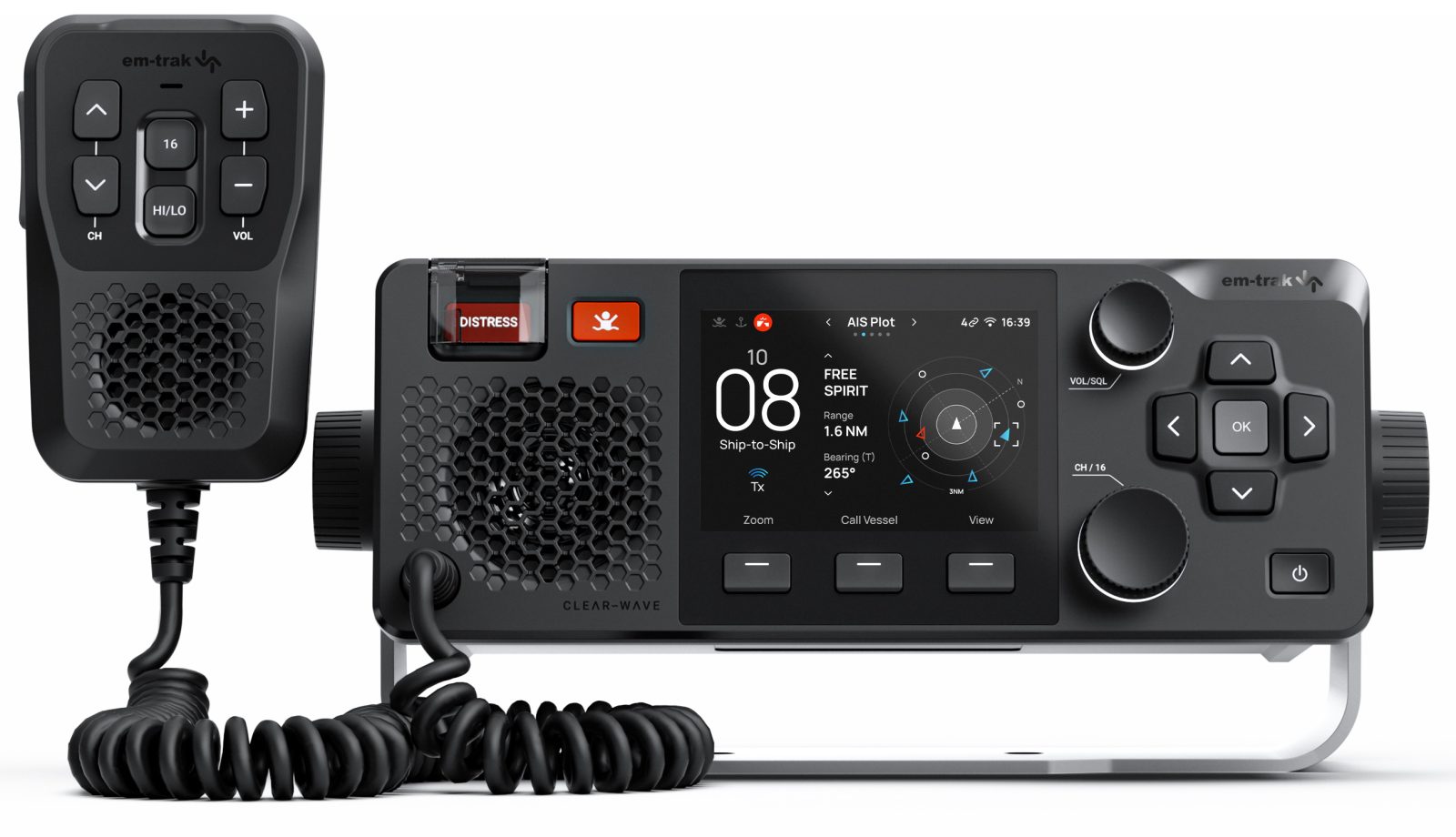
Like Cortex, Nexus will fully support mobile nav apps by streaming its AIS and GPS data over WiFi combined with other boat data like Depth and Wind multiplexed in via NMEA 0183 and/or 2000 — a feature Em-Trak calls AIS-Link. Other similarities include better SOTDMA style Class B AIS transmissions, the low loss of AIS or VHF signals using a single antenna, and the ability to be a WiFi access point or to join an existing boat WiFi network.
And like Cortex Onboard, the Nexus-Connect app will offer easy system configuration, diagnostics, firmware updating, AIS alarming — similar to what Em-Trak Connect-AIS does today — plus a whole lot more. Meanwhile — and quite unlike the black-box Cortex system architecture with its unusual and sometimes finicky WiFi-connected handsets — the Nexus-Base looks like a traditional VHF, familiar and reliable fist mic included.
Except that Nexus-Base will also support smartphones as additional VHF handsets, like the Icom M510 but with many more features. Em-Trak calls it VHF-Link (or MIC-Link in the system diagram at top), and says that once Nexus-Connect is running on Android and iOS phones around a boat — with well connected smartwatches also supported — their owners will still be able to take/make phone calls or use the internet.
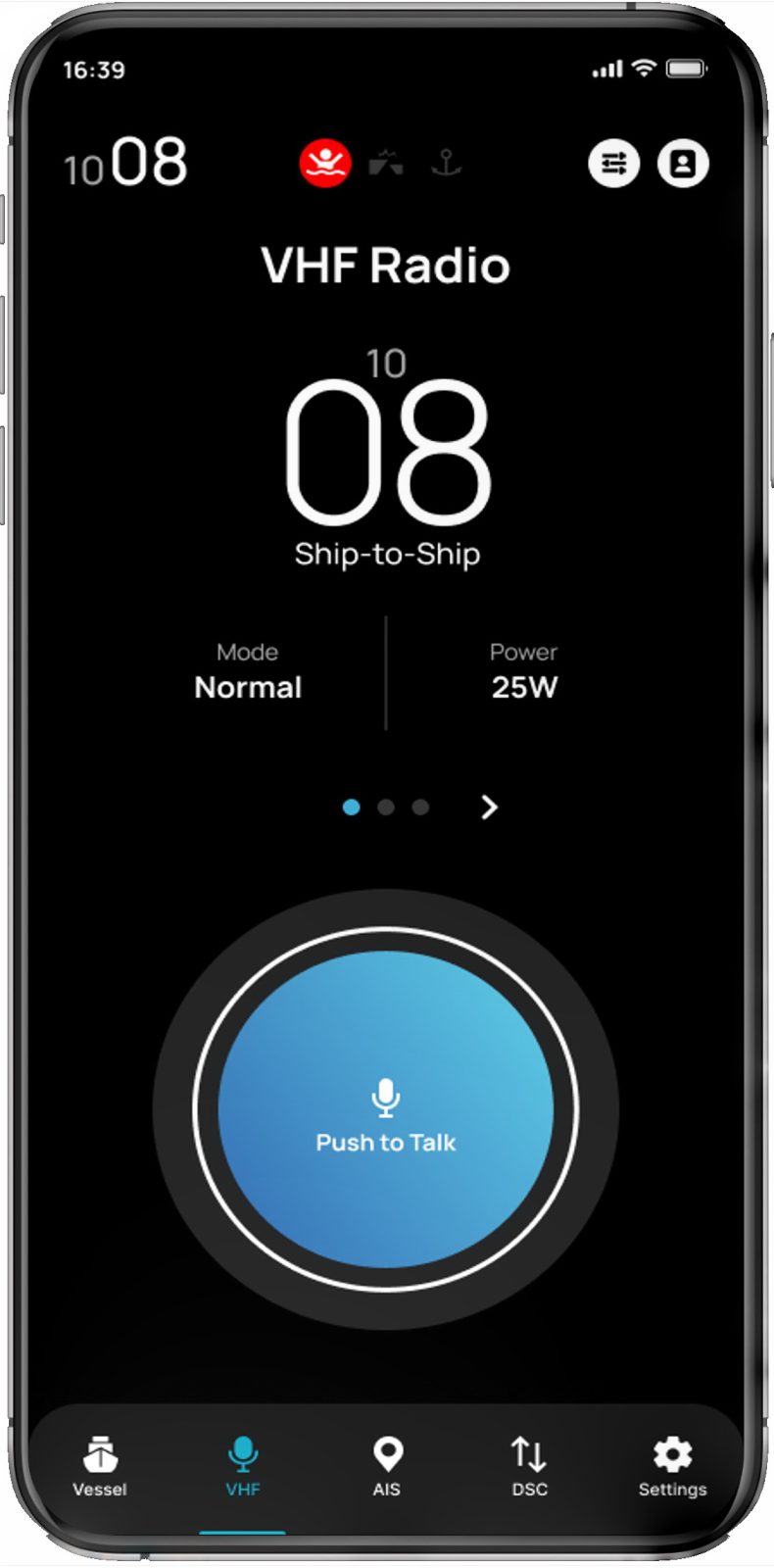
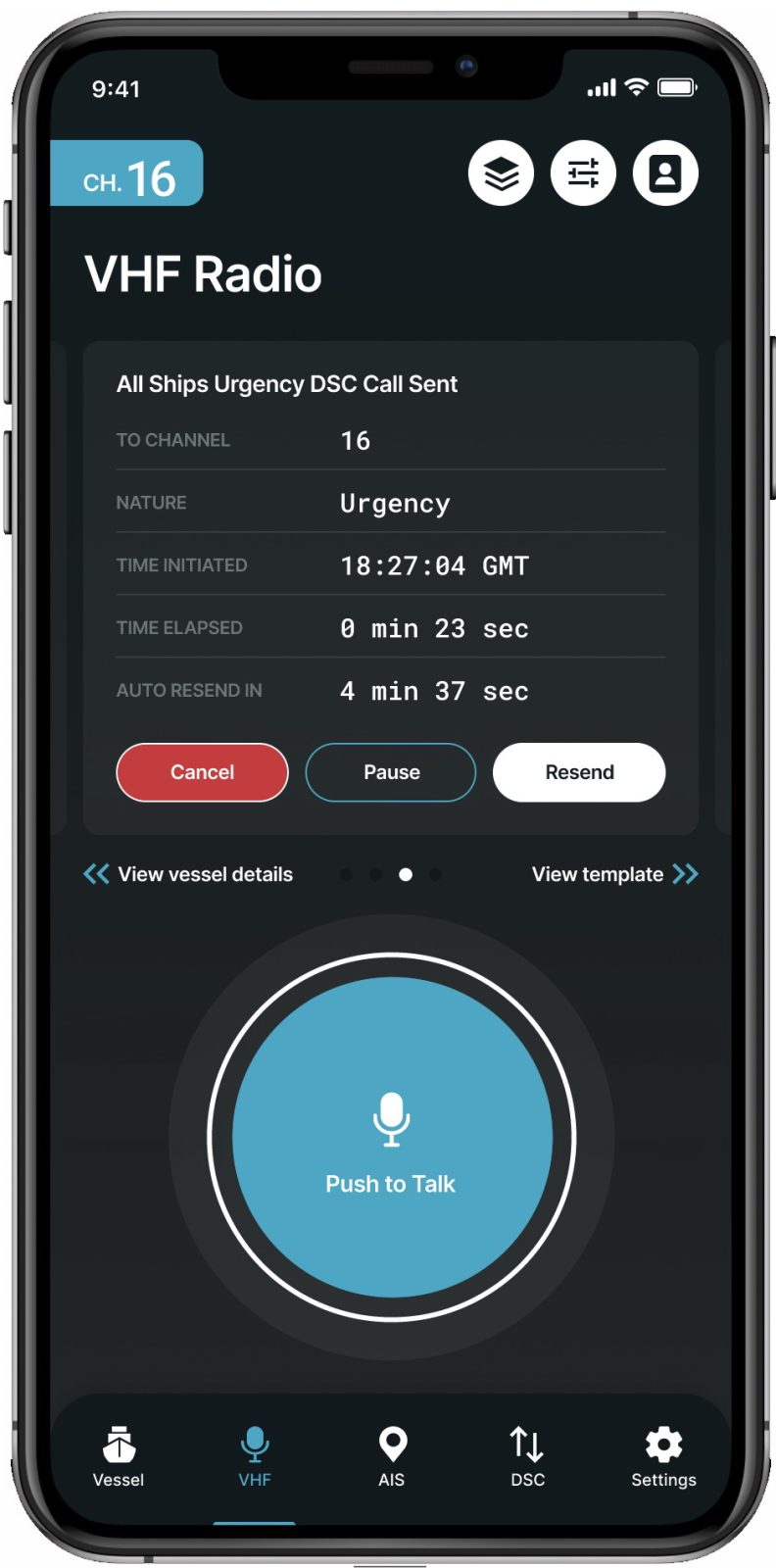
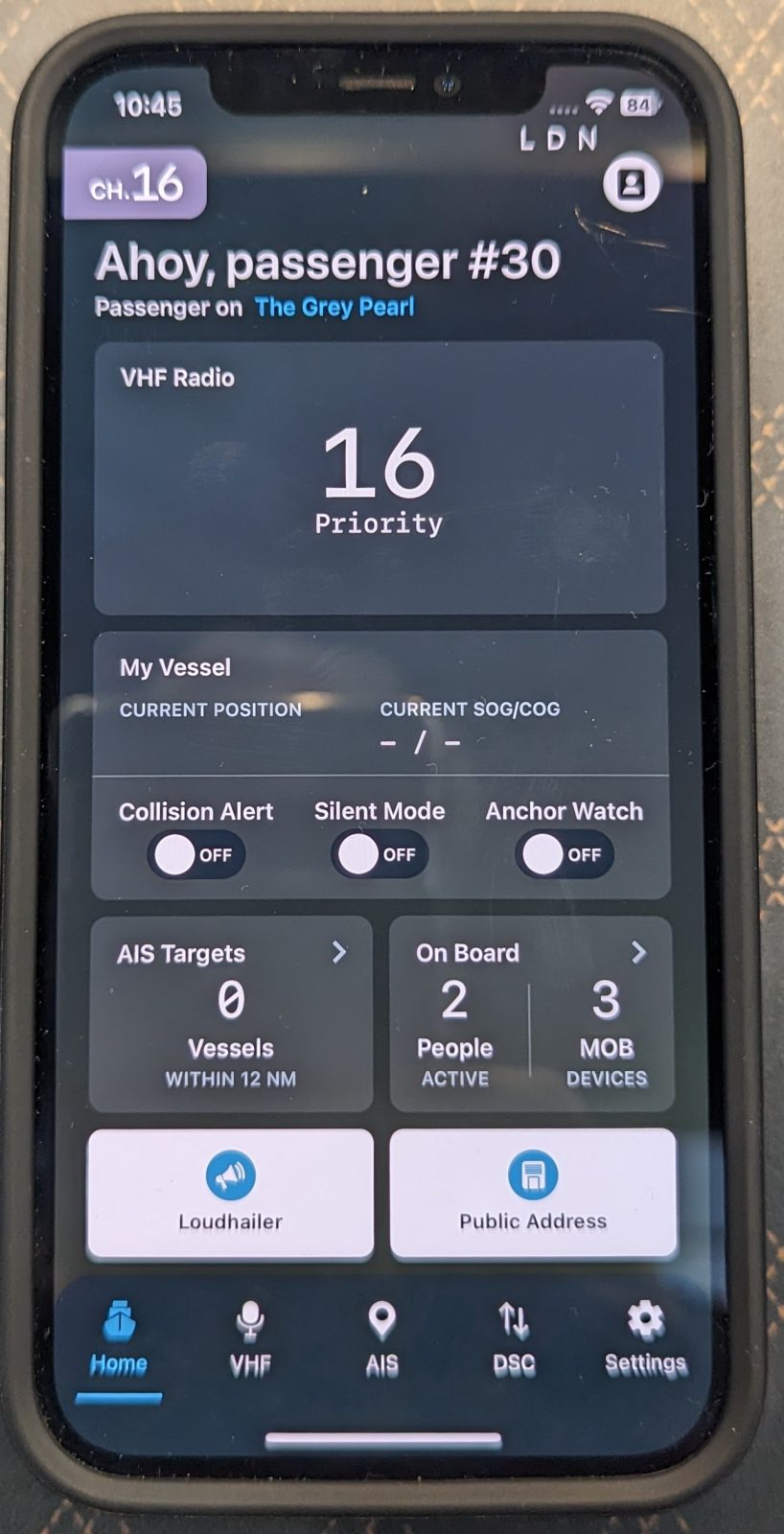
These screens are from a late-stage prototype of the Nexus-Connect app — and unfortunately, I could not dig around the user interface — but they already suggest its broad functionality. Aside from audio VHF, for instance, note the dedicated AIS and DSC pages, as well as the Collision Alert, Anchor Watch, and Loudhailer controls on the Home page. And while that “Public Address” button connects the phone app audio to all devices on a Nexus network, I’m told that a separate intercom feature can be used app-to-base or app-to-app.
So while Nexus Connect with VHF-Link to a Nexus-Base looks like a nice mashup of the information and controls you can get either on the Cortex or Icom apps — but not on both — did you also notice the “On Board — 2 People active — 3 MOB devices” panel on the Home screen? Well, that’s because Em-Trak figured out yet another way to redefine marine communications, which they call MOB-Link
MOB-Link
According to the brochure handed out at METS, the Nexus-Base allows…
… Android or Apple Smartwatches, cell phones and off-the-shelf wearable crew trackers to act as an MOB alert tag. Multiple devices can be connected simultaneously with built-in intelligence to prevent false alerts. If the connection between them and the NEXUS Base is broken, a MOB alert is triggered across all connected devices. NEXUS-Base will immediately display the location of the event and clear orientation (distance and bearing) for the skipper to manoeuvre back to the MOB location.
Em-Trak Nexus brochure, November 2023
Among the various technologies used for person-overboard devices, MOB-Link is a “proximity alarm” (as well explained in Marina Life by Bob Arrington). While proximity alarms do not track a person after they’ve gone overboard — like, say, a personal AIS beacon — the concept seems like an excellent bonus well suited to a system like Nexus.
With MOB-Link, the Nexus-Connect app you’re already using for VHF, intercom, AIS tracking, etc. also makes your phone into an MoB tag that constantly indicates its active status around the network but sets off audio and graphic alarms at the helm and elsewhere if its WiFi connection to your boat router or direct to the Nexus-Base becomes broken.
Moreover, since Nexus-Base includes Bluetooth as well as WiFi, MOB-Link will also work with third-party proximity alarm MoB tags like the ACR OLAS family. That could mean unobtrusive and inexpensive protection for crew not toting smartphones, or pets, or even a tender in tow. And by “built-in intelligence to prevent false alerts” Em-Trak means that Nexus favors longer-range WiFi over Bluetooth when there’s a choice — as with some smartwatches — and it may also use the network smartphones to extend Bluetooth coverage.
The Nexus-Base also includes an IMU to stabilize a boat’s low-speed COG, particularly useful for maintaining vessel orientation during MOB retrieval manuevers. And I’ll add that this notably innovative MOB-Link bonus feature does not preclude a Cortex-like MoB alarm and retrieval page triggered by an AIS or DSC beacon, both on the Base and the apps. Em-Trak has not mentioned it, but the Nexus developers have all the needed pieces when and if they have the time and motivation.
SRT and the Nexus-Handheld
This is a good place to note that the Em-Trak brand is only the tip-of-the-iceberg retail division of SRT Marine Systems, which has long developed all sorts of AIS-related devices, including “OEM AIS transceiver solutions” for the likes of Si-Tex, Digital Yacht, and many others. It’s also responsible for large Marine Domain Awareness (MDA) projects, from customized AIS modules to NASA-like monitoring centers. So:
- By their nature, SRT and Em-Trak are less prominent marine brand names than Garmin or Icom, but nonetheless, SRT is a major niche player with serious engineering and manufacturing resources on a global scale. Thus my earlier reference to a “strong competitor” when it comes to redefining maritime communications.
- If the redefinition should include Cortex-like off-boat monitoring, know that SRT’s VMS-100 and related transceivers can already integrate satellite and cellular data comms with AIS and boat networking.
- We will probably see the Nexus technology under different brand names, perhaps with custom casings and/or extra features. (For instance, the Nexus-Base also includes MFD-Link, an “embedded system to enable radio functionality integration within an MFD”.)
- SRT is also a publicly traded company, so curious monkeys like me can access info that some companies do not usually share.
That last point is how I know that Nexus development has been underway for at least three years, and that longtime CEO Simon Tucker is adamant that it won’t be released until it’s right — like zero lag in Nexus-Base to smartphone audio right, for one example. This reinforces my sense that Nexus could become a major marine communications system, and I hardly flinched when told that the Spring 2024 Nexus launch hoped for at METS has been delayed to Fall, following an extensive consumer-level beta test program.
So let’s hope Fall includes a smooth-running Em-Trak Nexus-Base with all the features so far seen in prototype and brochure, while realizing that innovative multifunction marine communications systems on this level are hard to get right, at least at first.

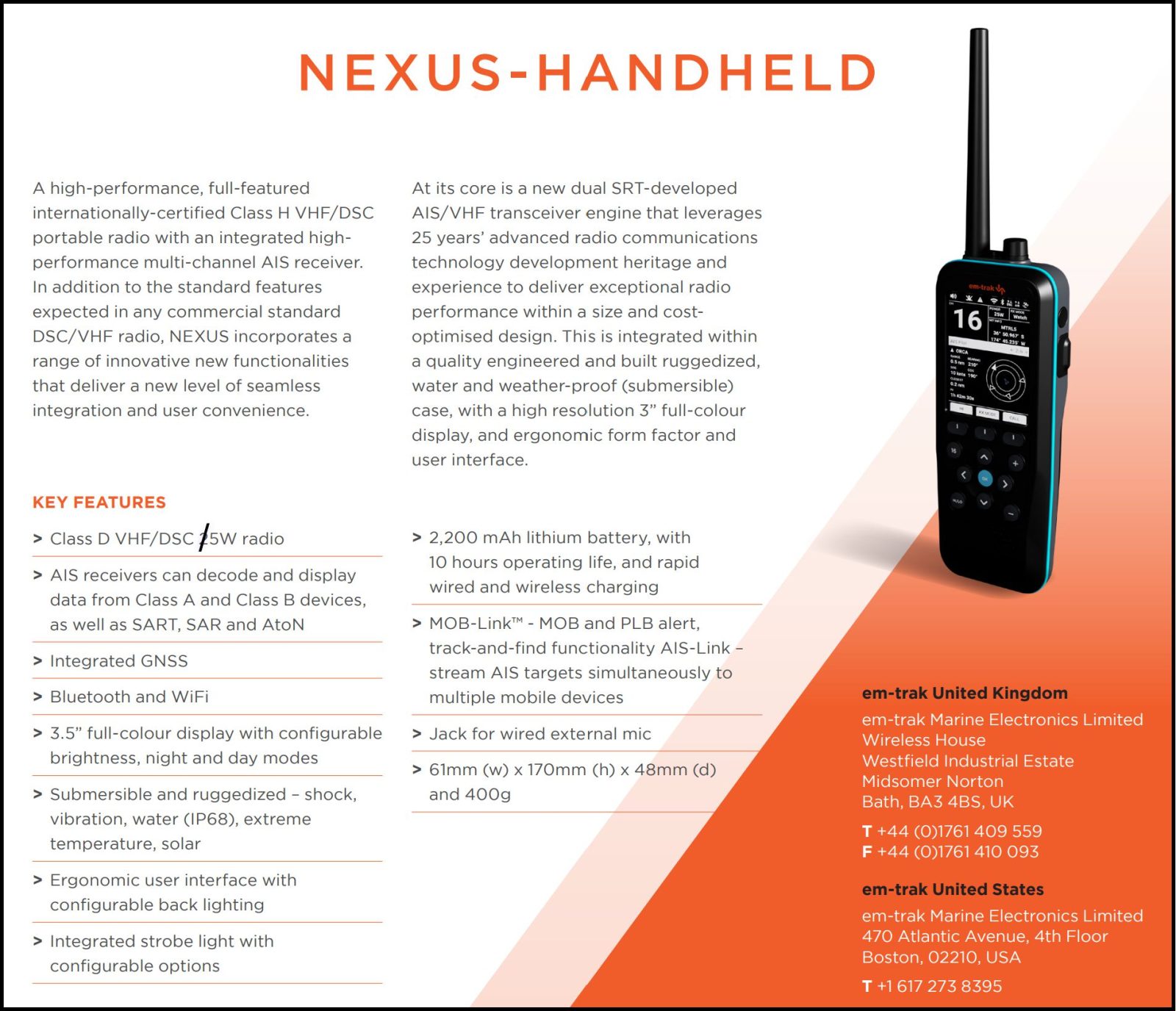
And, yes, a prototype Nexus-Handheld was also shown at METS, though the current development priority is Nexus-Base. But what a handheld! With Class H VHF, DSC, GNSS, a 3.5-inch color display, and 10 hours of battery life, the Nexus-Handheld strikes me as a nice update on the Standard Horizon HX8xx series I’ve long admired. (In fact, my 16-year-old HX850s still works fine and remains a valuable part of my portable marine safety kit. And an Icom M94D handheld would add AIX RX to this tool.)
But the Nexus-Handheld will also include AIS RX, plus WiFi and Bluetooth radios, while its software will support the same AIS-Link and MOB-Link features described above for the Nexus-Base. In other words, this first-of-its-kind handheld can serve AIS and GPS data to mobile nav apps while adding MOB proximity alarm to its DSC distress call safety abilities, no external power required except for charging. Wow!
I picture the Nexus-Handheld living its best life in a small boat, or in a delivery skipper’s go bag. But it could also provide redundancy on a bigger vessel, and if that boat has Nexus-Base, the Handheld becomes a special MOB-Link tag, able to automatically and repeatedly transmit its position to the Base for more accurate retrieval maneuvers if it accompanies someone or something overboard.
If you’ve gotten this far in this long entry, thank you and cheers to our shared interest in useful VHF and AIS innovations, the new Em-Trak Nexus in particular. We will have to wait patiently until SRT posts more detail and eventually ships Nexus-Base to users who can write about it. But it is already being advertised at Scan Marine DK where you can also download the METS Nexus brochure PDF.
And, yes, Scan Marine’s DKK 13,995 price translates to about USD $2,000, and SRT confirms that as the Nexus-Base target retail price while adding “although this may change” — which also applies to many aspects of Nexus, firmware and apps especially. By comparison, the Cortex V1 Hub and single Handset combo retail for $1,900, although in actuality it and Nexus are only vaguely similar and each is unique.
Which brings me to these questions, dear readers: Which, if any, of these products hoists your owner/operator flag? And/or what aspects of an integrated and redefined maritime communications system would enhance your boating, possible features not even mentioned above included?













A few years ago I installed an emtrak ais transceiver and a float hub remote monitoring system on a boat I have now sold.
But I could get neither of them to multiplex the way I thought they should. The ais unit had both 0183 and 2000 network connections and I thought I should be able to see 0183 data passed through to the 2000 mfd device. Sadly, that never happened.
Nick, Em-Trak / SRT did seem quite slow to adopt multiplexing despite the fact that it became a fairly popular feature of Vesper AIS about a decade ago. So I was glad to learn at METS that it will not only be included in Nexus but was added to all of Em-Trak’s B900 Series in a fairly recent firmware update, as detailed toward the end of the manual:
https://em-trak.com/wp-content/uploads/B900-Series-User-Manual-EN-v8.pdf
There are few 0183 to 2000 conversions — mainly Heading and autopilot messages — but the 2000 to 0183 data that also goes out over WiFi (and Bluetooth) is pretty much all most nav apps can use besides the GNNS and AIS info that has always streamed. B900 Series owners can find update info here: https://support.em-trak.com/hc/en-us
I would be more impressed if Em-Trak published actual RF specs for those radios. whiz-bang features are nice, but if you are in an area with lots of RF, you will appreciate NOT hearing all the intermod and assorted gronks and buzzing noises that poorly designed receivers pick up. I removed my SH GX1600 several years ago and replaced it with an Icom 506 for exactly that reason!
Well, Hartley, I’m hoping that SRT will post lots of Nexus detail when they’re ready, and note that while they have tons of AIS RF experience, Nexus will be their first audio VHF. Kind of like when Vesper developed Cortex. But I don’t think that SRT is messing with the SDR technology that took so long to optimize in Cortex.
For instance, Nexus scanning will be quite conventional, as in: “tri-watch is supported (even more so, the third channel doesn’t have to be the 2nd priority channel / 9) and channels can be favorited for a custom scan list”. And the only Rx recording will be “a short (30 second) skip back feature in the app to Replay Last”.
The development of radio systems is fantastic. However, I would really like to see a system that puts the AIS first with a simple, dedicated moving map display like the discontinued Vesper Vision2 (and its anchor alarm), then packages all the other radio functionality around that display with fixed mics like the Icom HM-195/229 Command Mics, and options for additional phone handsets. Putting AIS data on a plotter or tablet is great and very useful, but a clean, quick glance display next to a radar is very useful, simplifies watchstanding and makes it easy to decide when to pick up the handset and make a call or understand immediately why you are being called. I would even be happy with a dedicated accessory display for these radio systems that provided the AIS display and visual anchor watch without becoming another plotter or MFD.
Thanks, Jon. In my experience, even the original Vesper Vision had a lot going for it… https://panbo.com/hands-on-vesper-vision-class-b-ais-superstar/ … but when I moved to testing the XB8000 and eventually Cortex, I was satisfied just to get Vesper’s outstanding target prioritization and alarming on an iPad running WatchMate and now Cortex Onboard near the helm. In fact, I think that even the relatively small color screen on the Cortex handset does AIS target tracking surprisingly well. But in all cases a simple Vision-like background map could sometimes add valuable context, especially if I didn’t have a chartplotter with cruder AIS plotting nearby.
At any rate, I don’t know of any company working on the AIS-plotting-centric integrated VHF device you desire (but glad you spoke up here). On the other hand, I can picture how the next Cortex — the first under Garmin ownership — might put Cortex’s excellent AIS plotting on Garmin MFDs. Maybe they’ll even create a dedicated collision avoidance window in which good AIS target graphics are optionally underlaid with a simple base map and/or overlaid with radar. And Garmin has long had a simple way to place DSC calls to AIS targets if a Garmin VHF is on the same NMEA 2000 network: https://www8.garmin.com/manuals/webhelp/gpsmap7400-7600/EN-US/GUID-29FE4E9D-81AB-49E4-93B2-A9622AFED756.html
Also, major MFD companies like Raymarine and Furuno have improved their AIS plotting in recent years, and may have AIS/VHF integrations in the works, or may be checking out what’s possible with OEM versions of Nexus.
In other words, you might get the AIS plotting utility you’d like but not in the form you want.
Great to see an uber VHF like the Cortex with a fixed mount display and fist mic. The Cortex handheld was a “nice to have” for niche situations but was less of a fit for many as a primary interface, they needed a fixed mount version with a fist mic.
I hope that the Nexus will have an RJ45 connector (or something fancy) for Ethernet, even if it is a flying lead. This was missing from Cortex. I am uncomfortable with a mission critical data link being a wifi client of a ships router. Most of our installs will have a router, sometimes with external antennas because of a carbon deck and hull. Making a device a client of the router is done all the time, but it is step that usually requires a tech to set up, not an owner. This is a liability. Also, more wifi is never a good thing if it can be helped. Not a problem when away from the marina, but at the dock, wifi can struggle with adjacent boats interfering. Wires are a good solution!
Just to add to the carbon (sail) boat scenario… router is mounted aft to keep antenna cables short to external antennas with excellent performance on deck where it is needed, but weak performance in the carbon cave that is the nav station. This is of course an edge case, and we have ways to mitigate the below deck performance, but if my VHF now needs a SOLID signal 100% of the time, the ships network requirements get more complicated. A LAN wire from the Nexus solves this issue.
“I am uncomfortable with a mission critical data link being a wifi client of a ships router.” You make an excellent point, Eric, and moreover there is very little upside to using WiFi when the connected devices are fixed modules tucked somewhere in a boat’s complexity.
I doubt that the Em-Trak Nexus will have Ethernet — especially since NMEA OneNet hasn’t really gotten off the ground yet — but that’s where SRT’s OEM business might come into play. So a big systems company like Navico or Raymarine could order up their own Nexus model with plug’n’play Ethernet connectivity to their own MFDs etc. It also seems probable that the next Cortex will have Ethernet that works well with Garmin systems, as Garmin as already done with some Fusion models.
I don’t really know if or when such things might happen, but the results could be improved reliability and better access to “uber VHF”, AIS, intercom, MOB tagging, etc etc all around a boat.
The MOB feature in the intro got me reading through to the end. I still think my ultimate MOB wearable is an inexpensive device that included a sound maker that squawks at a user once it moves out of range of the base station, so as to remind the user to return to the boat and return the MOB wearable. I figure that same sound maker can be used to confirm operation when first attached to the user. Absent that, a very close second is a wearable like a watch the crew is already comfortable with and wearing! Nicely done!
Thanks, Dan. It strikes me that Nexus being open to third-party Bluetooth MoB proximity alarms makes that feature more possible.
(Also, for possibly confused readers, “remind the user to return to the boat and return the MOB wearable” does not reference an actual person overboard, but rather a crew person walking down the dock with Dan’s MoB alarm after they’ve tied up
Target price for the Nexus is 1,600 USD. ScanMarine’s Price is including 25% VAT
I bought the M510BB – an am running it through the Cortex Splitter. While things are much better than they used to be in cortex land, there are still plenty of ships that I hear on the M510BB that are silent on the Cortex.
What’s unclear to me is what I want to do with my “normal” panel mount M510 and its CT-500M WiFi hub for NMEA. I’m 50/50 for replacing it with another M510BB or even upgrading to an “EVO” just to get rid of the second box and extra wiring/complexity. I do appreciate the ability to use a smartphone with it to take net calls from the salon, and the bluetooth functionality you call out is super helpful in the M510: taking cruisers net calls from the salon, monitoring the “Big” radio when I go to the head, etc… Having that directly with the device has me thinking it might be good in the tender and perhaps paired with the Sena Nautitalk headsets so we can chat over the sound of wind, waves, and I can still monitor the radio without having it at volume 10.
Thanks, Sven. Sounds like your boat qualifies as a modern VHF test center!
I tested Cortex VHF reception versus good quality analog VHF a lot last season as the v2 firmware went through its many iterations. I have a Standard Horizon GX6000 attached to the M1 Hub’s splitter output and where the boat usually is in Camden, Maine, I can get 1 to 4 WX stations, some quite far away, but apparently sometimes receivable due to atmospheric conditions. The GX tags also correspond to the Cortex presets, so I can compare reception of more local traffic too.
At any rate, at first the GX6000 did noticeably better at receiving distant WX channels and sometimes caught more local calls that Cortex missed. But once v2.1 came along, the difference became hard to detect. But of course that’s my Cortex and GX installs and my VHF area. VHF performance, especially the very unusual Cortex software defined radio, seems to vary.
Also, glad to hear your enthusiasm about Icom M510 smartphone integration. Wouldn’t be cool if that got added to Cortex? The possibility has never been mentioned by Vesper or Garmin, but seems like it would be easy — especially for Android phones, since that’s what the handsets run — and a nice gift for the Cortex owners who have suffered frustrations during slow development.
Any word on when this coming? Or a V2 Cortex? Seems like innovation on the VHF front has really slowed. I get that VHF is what it is but am disappointed to not see better integration of MOB like what is described on the Em-Trak. I currently have a very clunky Garmin 315 that I am desperate to turn off and replace with something better but can’t see investing in a V1 Cortex that must be nearing the end of product cycle.
Hi Tom, The Em-Trak Nexus system is making progress, but is not even listed at em-trak.com yet. And I have not heard a peep about a new Cortex , or even significant improvements to the v2 Cortex software I’m still using. This is complicated tech with low market demand so far.
However, the original Cortex M1, still available at about $1,000, is a terrific Class B AIS with all sorts of extra features not available in any other Class B:
https://www.hodgesmarine.com/ves010-02815-00-vesper-cortex-m1-full-class-b-sotdma-smartais-tr.html
Note that only the remote monitoring via cellular — with free features pretty minimal — is limited to U.S. waters, and the M1 has an excellent built-in antenna splitter so is easily installed with a quality VHF like the Standard Horizon 2400 I’ve been enjoying for the last year (and now superceded by the GX2410, though I don’t know the differences).
That combination makes for a powerful AIS/VHF setup, but you can also try a Cortex handset to see if the amazing v2 VHF features are worth the cost, while still using a single antenna.
Thanks Ben – was secretly hoping you would give me more hope The VHF features are my primary interest as the boat has a Garmin AIS800, it’s the Garmin VHF that is super lacking and clunky. Will stick it out a bit longer and hope that we see the Em-trak soon (MOB and paired handheld features look really nice), Cortex VHF has everything I need except being 5+ year old tech at $1800+, just can’t justify that when I already have a perfectly good AIS. If it was a new product I might think differenlty. Oh well… back to my unreadable Garmin display that takes two hands and two button hits and a knob to change the volume…
The VHF features are my primary interest as the boat has a Garmin AIS800, it’s the Garmin VHF that is super lacking and clunky. Will stick it out a bit longer and hope that we see the Em-trak soon (MOB and paired handheld features look really nice), Cortex VHF has everything I need except being 5+ year old tech at $1800+, just can’t justify that when I already have a perfectly good AIS. If it was a new product I might think differenlty. Oh well… back to my unreadable Garmin display that takes two hands and two button hits and a knob to change the volume…
Em-trak X100 official information I received as a seller : This new product will be available for shipment starting February 2025 EU .
Thanks for the date, Christopher. In fact, I see it advertised in the U.S. too — https://anchorexpress.com/products/em-trak-x100-vhf-w-class-b-ais-431-0001 — but given multiple past delays, I’d be leery about getting a Nexus X100 soon. This mix of technologies, plus the many possible added features, is hard to get right.
Hi Ben. A notice is going out next week on the status. It won’t be Feb, I’m pretty sure. Btw – the ad you referenced is from an unauthorized dealer. Their special pricing is quite unrealistic and well below the MAP. More to come.
Thanks, Alec, and please let us know the new X100 availability date when possible.
Also, I have no experience with Anchor Express, and would hesitate to use them because I see no physical address on their website, few online reviews, and no presence at TrustPilot.com
Which suggests that it is a small operation, at minimum.
Finally, will $1,699 be the Minimum Advertised Price in the U.S., as implied by Anchor and also this Polish online retailer?
https://ts2.store/en/maritime/18867-em-trak-x100-vhf-wclass-b-ais.html
Thx Ben.
$1,699 is the suggested retail price. Minimum advertised price would be around $1,530. Will keep you posted.